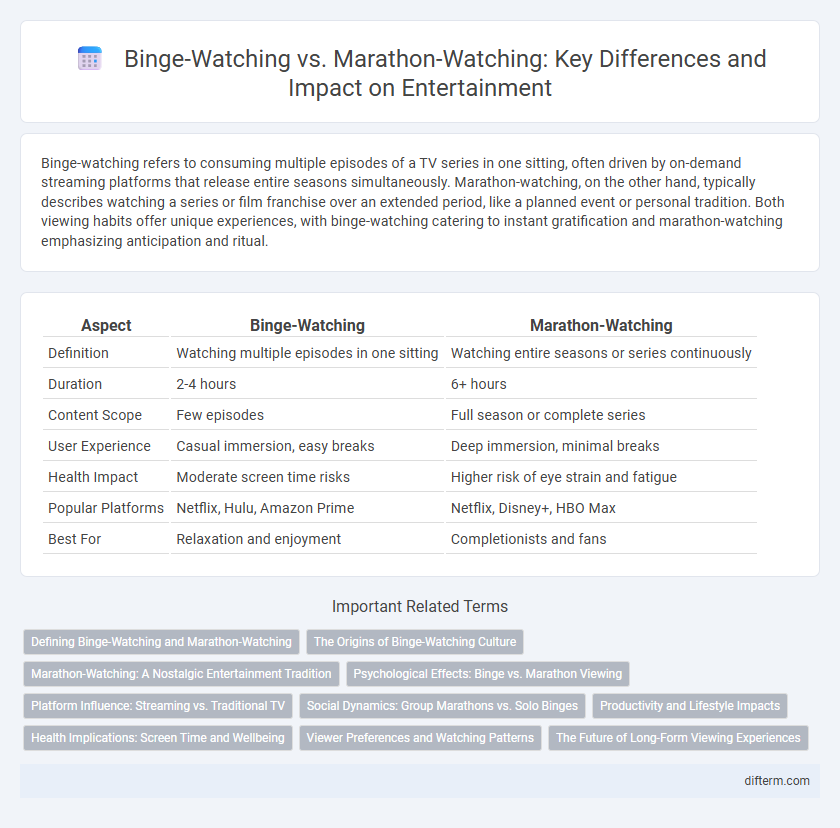Binge-watching refers to consuming multiple episodes of a TV series in one sitting, often driven by on-demand streaming platforms that release entire seasons simultaneously. Marathon-watching, on the other hand, typically describes watching a series or film franchise over an extended period, like a planned event or personal tradition. Both viewing habits offer unique experiences, with binge-watching catering to instant gratification and marathon-watching emphasizing anticipation and ritual.
Table of Comparison
| Aspect | Binge-Watching | Marathon-Watching |
|---|---|---|
| Definition | Watching multiple episodes in one sitting | Watching entire seasons or series continuously |
| Duration | 2-4 hours | 6+ hours |
| Content Scope | Few episodes | Full season or complete series |
| User Experience | Casual immersion, easy breaks | Deep immersion, minimal breaks |
| Health Impact | Moderate screen time risks | Higher risk of eye strain and fatigue |
| Popular Platforms | Netflix, Hulu, Amazon Prime | Netflix, Disney+, HBO Max |
| Best For | Relaxation and enjoyment | Completionists and fans |
Defining Binge-Watching and Marathon-Watching
Binge-watching refers to consuming multiple episodes of a TV series in a single sitting, often driven by streaming platforms releasing entire seasons at once. Marathon-watching, on the other hand, involves dedicated viewing of a series or movie franchise over an extended period, typically planned in advance. Both practices highlight evolving media consumption behaviors, influenced by digital availability and audience engagement patterns.
The Origins of Binge-Watching Culture
Binge-watching originated with the rise of streaming platforms like Netflix, which pioneered releasing entire seasons at once, allowing viewers to consume multiple episodes in a single sitting. This shift transformed traditional weekly TV viewing, creating a culture centered around immersive, uninterrupted storytelling. The term "marathon-watching" predates binge-watching, referring to scheduled multi-episode events, but streaming technology popularized on-demand binge consumption.
Marathon-Watching: A Nostalgic Entertainment Tradition
Marathon-watching evokes a nostalgic entertainment tradition rooted in gathering friends or family to enjoy entire seasons or film series in one dedicated session, preserving a sense of communal storytelling and shared experience. Unlike binge-watching, which often emphasizes rapid consumption fueled by streaming algorithms, marathon-watching highlights intentional pacing, fostering deeper emotional connections and appreciation for narrative arcs. This cherished practice remains a beloved cultural ritual, bridging generations through classic TV show reruns, movie trilogies, and themed event viewings.
Psychological Effects: Binge vs. Marathon Viewing
Binge-watching often leads to immediate gratification and heightened emotional engagement, but it can also cause increased stress, fatigue, and reduced attention span due to prolonged screen exposure. Marathon-watching, involving scheduled breaks and pacing, tends to mitigate negative psychological effects by promoting better retention and allowing the brain to process narrative content more effectively. Studies from the Journal of Media Psychology reveal that pacing viewing sessions reduces symptoms of anxiety and improves overall enjoyment compared to binge sessions.
Platform Influence: Streaming vs. Traditional TV
Streaming platforms revolutionize binge-watching by offering entire seasons on demand, enabling viewers to consume content uninterrupted at their own pace. Traditional TV's scheduled programming enforces marathon-watching, limiting viewer control and prolonging series engagement through weekly episodes. The on-demand model of streaming fosters immersive experiences and quicker narrative consumption, while traditional TV's format sustains anticipation and community discussions over time.
Social Dynamics: Group Marathons vs. Solo Binges
Group marathons create a shared social experience that strengthens bonds through real-time reactions and discussions, enhancing emotional engagement with the content. Solo binge-watching offers personalized control over pacing and narrative immersion, catering to individual preferences and introspection. The choice between group marathons and solo binges reflects differing social dynamics, with group settings fostering community and solo sessions promoting solitude and self-reflection.
Productivity and Lifestyle Impacts
Binge-watching often leads to decreased productivity due to prolonged screen time and disrupted sleep patterns, negatively affecting daily routines and work performance. Marathon-watching, characterized by scheduled viewing sessions, can be integrated more easily into a balanced lifestyle, reducing stress and allowing for planned breaks. Managing screen time through intentional viewing habits supports better mental health and overall lifestyle productivity.
Health Implications: Screen Time and Wellbeing
Binge-watching and marathon-watching significantly increase screen time, leading to potential health risks such as eye strain, sleep disruption, and sedentary lifestyle effects. Extended sessions may elevate the risk of mental health issues, including anxiety and depression, due to prolonged isolation and reduced physical activity. Implementing regular breaks and ergonomic viewing practices can mitigate negative impacts on wellbeing during intense entertainment consumption.
Viewer Preferences and Watching Patterns
Binge-watching involves consuming multiple episodes in rapid succession, often driven by cliffhangers and narrative hooks, while marathon-watching typically refers to planned sessions of extended viewing, such as a full season or series in one sitting. Viewer preferences vary based on factors like time availability, emotional investment, and content type, with binge-watchers favoring episodic pacing and marathon-watchers opting for immersive narratives. Streaming platforms analyze these watching patterns through user data to optimize content release strategies and personalized recommendations.
The Future of Long-Form Viewing Experiences
Binge-watching and marathon-watching represent evolving patterns of consuming long-form entertainment, with binge-watching typically involving rapid consumption of multiple episodes in a series, while marathon-watching often denotes organized, extended viewing sessions. Advances in streaming technology and AI personalization are driving the future of long-form viewing experiences by offering tailored content recommendations and interactive features. Immersive formats such as virtual reality and augmented reality promise to transform audience engagement, making long-form entertainment more dynamic and participatory.
binge-watching vs marathon-watching Infographic

 difterm.com
difterm.com